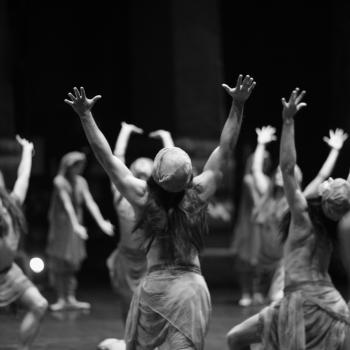Connor Wood
Here, try something: Take a minute to think about one of your best friends. How did you get to be close? I don’t just mean how you met – at a party, taking Freshman Comp together, serving on the same top-secret CIA mission to Burma – I mean how you got to be friends. If you’re like most people, the chances are good that your friendship blossomed by sharing not real things, but imaginary ones. Relationships, research in anthropology and ritual studies suggests, flower best when people take part in shared, alternate worlds of imagination – subjunctive worlds that are cordoned off from reality, where our minds can play.
Want to hear a mildly alarming example of what I’m talking about? My girlfriend and I were leafing through an illustrated children’s book a few months ago, just for fun. (What, you don’t ever secretly skim through children’s books?) The book was about the stars and the night sky. About three pages into the story, the text began waxing poetic about the beautiful dots of light in the heavens, rhapsodizing that it almost looked as if you could sweep them up in your hands.
…Except that, unlike any other kid’s book I’ve ever read, this book unexpectedly made a big show of stopping the narrative right here to grandly emphasize that, of course, you couldn’t actually gather up the stars in your hands – not in real life. Get real, kids.
Wow. My imagination felt like a sponge that had been sat on by Bertrand Russell.
In mild shock, we stuffed the book back onto the shelf. Later that evening, the two of us began reading a great book by Roald Dahl, in which giants are definitely real and dreams can be captured with nets. Guess which one of these two books made us feel closer to one another? I’ll give you a hint: Roald Dahl made us feel closer to one another. Reading a wild story in which unrealistic things happen and the impossible becomes real is a great way to feel like you and another person are secret comrades, hidden away from the dreariness of reality like children in a tree fort – privileged inhabitants of a rich but made-up world.
Great, you’re thinking. The writer of this blog is an infantile who pines for childhood. Is there anybody writing about religion who isn’t developmentally compromised?
But hold on a second. Think back on your life thus far. When is it that you made friends the most quickly and easily? According to quite a bit of research, as well as the obvious facts of most people’s experience, it was probably when you were young. And what do we do with friends when we’re young? Well, we do lots of things: go on school trips together, share homework answers, attend birthday parties.
But we also play.
We develop imaginary worlds that operate according to rules we invent. We make up new games with rules that don’t match any official sport. We play make-believe. We enter into alternative realities together.
I’d submit that this same dynamic also continues even when we move beyond childhood and into early adulthood. I don’t know about you, but when I was in college my friendships certainly involved a lot of goofing off and playing – making up games, talking for hours about how the world would be if things were different. Since I went to the first two years of college on the shores of Lake Michigan, this type of conversation would often take place late at night, on the beach, as my friends and I watched the waves crash beneath the stars. Surrounded by elemental sights and sounds, it was easy for us to imagine different versions of reality – how our lives would be if entirely different rules applied.
It’s this “would-if” construction – known in grammatical parlance as the “subjunctive” tense – that is absolutely vital for friendships. You can never be truly good friends, deep friends, with someone unless you have sat around with them, preferably outside, and entertained wild visions of how the world could be.
Several puzzling human phenomena suddenly make a lot more sense when you look at them in light of this subjunctive, “what-if” facet of human experience. For example, it helps explain why social movements and revolutions create such tight bonds among the people who take part in them: if you’re working side-by-side with someone to fight for an entirely new and different vision of the world, you’re by default inhabiting a subjunctive reality together. It’s like playing, but with real consequences (like, oh, toppled governments). You feel bonded to your co-revolutionaries, in part, because you’re all living in the same imaginary world.*
The fact that the subjunctive sense is vital for social bonding also does a lot to explain why we stop making new, close friends as we grow older. By the time we’re in our 30s, how the world could be has generally given way to the immediate practicalities of how it is. You have bills to pay, a career to build, kids to feed. Most of the other adults you interact with day-to-day are sharing, collaborating on, or competing with you in most of the same sorts of basic practical tasks. So you might get to know and even like each other, but because you’re spending all your time dealing with the world as it is, you never fall into that deeper space where reality subsides and imagination and play begins. So you never quite become real friends.
Finally, this perspective does quite a lot to explain why religion plays a central role in many people’s lives, and how. The sociologist Adam Seligman and anthropologist Rob Weller – the guys from whom I’ve stolen my emphasis on the subjunctive tense – have written an entire book on this, arguing that ritual in particular helps to create shared social experiences of “what-if.” For example, the Catholic Eucharist wafer is clearly, to the naked eye, not a piece of flesh. But the ritual taking of Communion invites participants into a shared, secret reality: how the world would be if it were flesh. By shifting from the everyday and practical to the subjunctive and richly imaginative, ritual forges social worlds:
The creation of “as if” worlds is a central aspect of ritual action, which we see as necessary for human life.…(R)itual creates a shared, illusory world. Participants practicing ritual act as if the world produced in ritual were in fact a real one. And they do so fully conscious that such a subjunctive world exists in endless tension with an alternate world of daily experience.
That last sentence is key: ritual, and imagination games, only work if they are not repeating how the world actually is. Everybody already knows how the real world is – how much fun is that? Instead, they have to make claims that are self-evidently totally different from how things actually are. This is how shared imaginative worlds are created, and how communities and deep relationships are formed.
Over the past decade, a lot of research in the scientific study of religion has focused on how religion functions to bind communities together, for good or ill. But the precise mechanisms for how this binding works aren’t always clear. In light of work being done in ritual studies, as well as research showing that atheists don’t enter into imaginative worlds as easily and that accepting supernatural claims creates emotional bonds between people, it’s possible that religions help form communities, in part, by turning people into “secret comrades.” Like children hiding together in a fort, members of religious communities inhabit alternate worlds together – visions of reality that defy the logic and rules of mundane reality. If you’re a secular-minded rationalist, this idea probably makes you cringe. But it’s not rationality that brings people together into friendships that stand through the ages. It’s the power of imagination, of idealism, to envision worlds that aren’t real yet, but could be – or even that couldn’t be.
_________
* At least until you win the revolution. Then the imaginary world, of course, suddenly turns real, which means it loses darn near all its power to forge those idealistic friendships. This is why victorious revolutionaries are famous for guillotining each other as soon as the last shots are fired.












